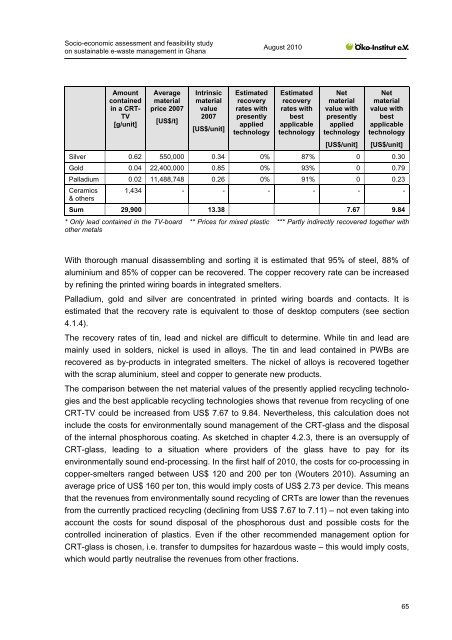Socio-economic assessment and feasibility study on - Öko-Institut eV
Socio-economic assessment and feasibility study on - Öko-Institut eV
Socio-economic assessment and feasibility study on - Öko-Institut eV
Create successful ePaper yourself
Turn your PDF publications into a flip-book with our unique Google optimized e-Paper software.
<str<strong>on</strong>g>Socio</str<strong>on</strong>g>-<str<strong>on</strong>g>ec<strong>on</strong>omic</str<strong>on</strong>g> <str<strong>on</strong>g>assessment</str<strong>on</strong>g> <str<strong>on</strong>g>and</str<strong>on</strong>g> <str<strong>on</strong>g>feasibility</str<strong>on</strong>g> <str<strong>on</strong>g>study</str<strong>on</strong>g><br />
<strong>on</strong> sustainable e-waste management in Ghana<br />
Amount<br />
c<strong>on</strong>tained<br />
in a CRT-<br />
TV<br />
[g/unit]<br />
Average<br />
material<br />
price 2007<br />
[US$/t]<br />
Intrinsic<br />
material<br />
value<br />
2007<br />
[US$/unit]<br />
Estimated<br />
recovery<br />
rates with<br />
presently<br />
applied<br />
technology<br />
August 2010<br />
Estimated<br />
recovery<br />
rates with<br />
best<br />
applicable<br />
technology<br />
Net<br />
material<br />
value with<br />
presently<br />
applied<br />
technology<br />
[US$/unit]<br />
Net<br />
material<br />
value with<br />
best<br />
applicable<br />
technology<br />
[US$/unit]<br />
Silver 0.62 550,000 0.34 0% 87% 0 0.30<br />
Gold 0.04 22,400,000 0.85 0% 93% 0 0.79<br />
Palladium 0.02 11,488,748 0.26 0% 91% 0 0.23<br />
Ceramics<br />
& others<br />
1,434 - - - - - -<br />
Sum 29,900 13.38 7.67 9.84<br />
* Only lead c<strong>on</strong>tained in the TV-board ** Prices for mixed plastic *** Partly indirectly recovered together with<br />
other metals<br />
With thorough manual disassembling <str<strong>on</strong>g>and</str<strong>on</strong>g> sorting it is estimated that 95% of steel, 88% of<br />
aluminium <str<strong>on</strong>g>and</str<strong>on</strong>g> 85% of copper can be recovered. The copper recovery rate can be increased<br />
by refining the printed wiring boards in integrated smelters.<br />
Palladium, gold <str<strong>on</strong>g>and</str<strong>on</strong>g> silver are c<strong>on</strong>centrated in printed wiring boards <str<strong>on</strong>g>and</str<strong>on</strong>g> c<strong>on</strong>tacts. It is<br />
estimated that the recovery rate is equivalent to those of desktop computers (see secti<strong>on</strong><br />
4.1.4).<br />
The recovery rates of tin, lead <str<strong>on</strong>g>and</str<strong>on</strong>g> nickel are difficult to determine. While tin <str<strong>on</strong>g>and</str<strong>on</strong>g> lead are<br />
mainly used in solders, nickel is used in alloys. The tin <str<strong>on</strong>g>and</str<strong>on</strong>g> lead c<strong>on</strong>tained in PWBs are<br />
recovered as by-products in integrated smelters. The nickel of alloys is recovered together<br />
with the scrap aluminium, steel <str<strong>on</strong>g>and</str<strong>on</strong>g> copper to generate new products.<br />
The comparis<strong>on</strong> between the net material values of the presently applied recycling technologies<br />
<str<strong>on</strong>g>and</str<strong>on</strong>g> the best applicable recycling technologies shows that revenue from recycling of <strong>on</strong>e<br />
CRT-TV could be increased from US$ 7.67 to 9.84. Nevertheless, this calculati<strong>on</strong> does not<br />
include the costs for envir<strong>on</strong>mentally sound management of the CRT-glass <str<strong>on</strong>g>and</str<strong>on</strong>g> the disposal<br />
of the internal phosphorous coating. As sketched in chapter 4.2.3, there is an oversupply of<br />
CRT-glass, leading to a situati<strong>on</strong> where providers of the glass have to pay for its<br />
envir<strong>on</strong>mentally sound end-processing. In the first half of 2010, the costs for co-processing in<br />
copper-smelters ranged between US$ 120 <str<strong>on</strong>g>and</str<strong>on</strong>g> 200 per t<strong>on</strong> (Wouters 2010). Assuming an<br />
average price of US$ 160 per t<strong>on</strong>, this would imply costs of US$ 2.73 per device. This means<br />
that the revenues from envir<strong>on</strong>mentally sound recycling of CRTs are lower than the revenues<br />
from the currently practiced recycling (declining from US$ 7.67 to 7.11) – not even taking into<br />
account the costs for sound disposal of the phosphorous dust <str<strong>on</strong>g>and</str<strong>on</strong>g> possible costs for the<br />
c<strong>on</strong>trolled incinerati<strong>on</strong> of plastics. Even if the other recommended management opti<strong>on</strong> for<br />
CRT-glass is chosen, i.e. transfer to dumpsites for hazardous waste – this would imply costs,<br />
which would partly neutralise the revenues from other fracti<strong>on</strong>s.<br />
65

















